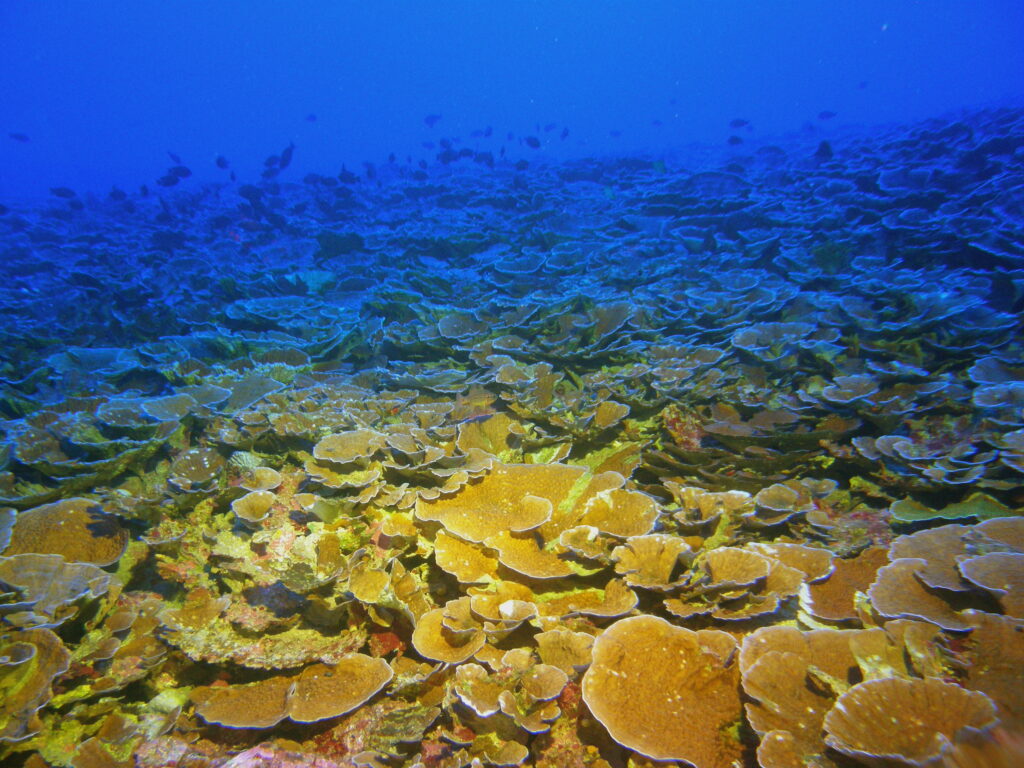We investigated Hawaii’s mesophotic coral ecosystems to better understand them and their relationship to shallower reefs. We found reefs off Maui’s southwestern coast at depths of 30–130 meters (98–426 ft) with large areas of unusually high coral cover, near 100 percent, and large beds of macroalgae. We found fishes present at both shallow and mesophotic depths are genetically the same and should be managed as a single population. If managed well, mesophotic fishes may replenish shallow reefs.

Why We Care
With the overall health of shallow coral reefs in decline, it is important to understand the value and role of mesophotic coral ecosystems in tropical and subtropical waters. These ecosystems are found most commonly at depths from 30–40 meters (98–131 ft) to deeper than 150 meters (492 ft). The dominant structural habitat in the mesophotic zone can be corals, sponges, algae, and limestone formations associated with ancient sea stands. Considered as extensions of shallow coral reef ecosystems, mesophotic coral ecosystems are thought to have biological, physical, and chemical connectivity with shallow coral reefs.
Although these ecosystems harbor many of the species found in their shallower water counterparts, many other species occur only in the deeper ecosystems and they are often inhabited by a relatively high number of fishes and invertebrates that are endemic or unique to the Hawaiian Islands. It has been hypothesized that mesophotic coral ecosystems can serve as sources to reseed or replenish degraded shallow-water coral reef species.
What We Did
We:
- characterized the geophysical, ecological, and physiological attributes of mesophotic coral ecosystems,
- documented species associated with mesophotic coral ecosystems,
- determined the potential connectivity of these mesophotic ecosystems to shallower reefs, and
- developed a simplified model to predict the occurrence of mesophotic coral ecosystems.
The study site was located in the southern Au‘au Channel between the Hawaiian Islands of Maui and Lana‘i. This site is premium mesophotic habitat and is the result of key factors working together: clear water that allows deep light penetration combined with a submerged terrace at an ideal depth that connects the islands and forms a natural flume that improves water flow and enhances productivity. These factors permit photosynthesis to occur at greater depths allowing for proliferation of corals and algae.
This project is part of the Deep Coral Reef Ecosystem Studies (Deep-CRES) Program and funded by NCCOS and the Office of Ocean Exploration and Research. It is led by Richard Pyle, Bernice P. Bishop Museum. Project partners include Ken Longenecker, Holly Bolick, and Ross Langston, Bernice P. Bishop Museum; Celia Smith and Heather Spalding, University of Hawaii Department of Botany; Brian Popp and Christina J. Bradley, University of Hawaii Department of Geology and Geophysics; Anthony Montgomery, Hawaii Department of Land and Natural Resources; and Frank Parrish and John Rooney of the NOAA Pacific Islands Fisheries Science Center.
What We Found and Management Implications
We found that mesophotic coral ecosystems in the Au’au Channel are:
- A unique source of coral and algal diversity in Hawaii – The Au‘au Channel consists of the most expansive examples of mesophotic coral ecosystems discovered to date in Hawaii. It has large areas of 100 percent coral cover at 50–90 meters (164–295 ft) and large beds of algae that are currently not impacted by land-based sources of pollution. However, they should be considered in any future coastal zone management of the region that may impact them, such as cable laying, dredging dump sites, and deep sewer outfalls.
- Well-connected to shallow-water fishes – The same fish species found at both shallow and mesophotic depths do not differ in what they eat or in their genetic makeup. The management implication is that reef fish species that are found at both depths can be managed as a single population.
- Home to twice the number of endemic fish species compared to shallower reefs – We found that 45 percent of the fish species recorded at mesophotic depths were endemic or unique to the Hawaiian Islands, which is more than double the percent of endemic species found in shallow reefs recorded at 22 percent. The dominance of Hawaiian endemic fish species in mesophotic habitats is an important biodiversity consideration and should be taken into account in the management of commercial and recreational removals of fish including for the aquarium trade.
- Refuges for some shallow reef fishes and coral species – Given that mesophotic and shallow fish communities are genetically similar, mesophotic fishes may help replenish species that are over-exploited on shallower reefs. Some coral species common on shallow reefs (less than 30 meters in depth) are also found in the upper mesophotic zone (between 35–50 meters in depth (114–164 ft)) and may provide “backup protection” of coral larvae to assist shallow reefs under stress.
